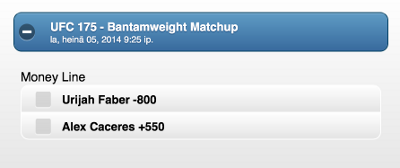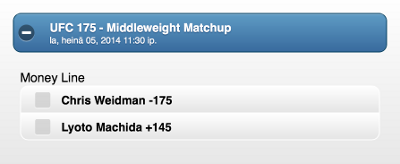The most common forms of betting on sports can be categorized as following:
- Moneyline Bets
- Point Spread Bets
- Over / Under Bets
- Parlay Bets
- Teaser Bets
-
Bonus: 50% up to $250.

- Best for USA.
- Fastest player cashouts.
- Sportsbook and casino.
Moneyline Bets
Moneyline bets are as simplest of them all: there’s always the favourite (the team or athlete more likely to win) and the underdog (the team or athlete less likely to win). When you bet on the favourite, you always win less than your bet size; when you bet on the underdog, you always win more than your bet size (suggesting, of course, that your bet is successful).
When the bet is minus-something, you need to risk that amount to win $100; when the bet is plus-something, you need to risk $100 to win that amount. (By the way, $100 is used in this example to represent the ratio of bet size to potential winnings – you can bet whatever you want, of course).
Here’s an example of a boxing match as a moneyline bet:
Muhammad Ali -230
Mike Tyson +180
You would have to bet $230 on Ali to win $100, and $100 on Tyson to win $180. In this case, therefore, Ali is the favourite and Tyson the underdog. The negative number always means how much you have to risk to win $100; the positive number always means how much you can win by risking $100.
In Europe, decimals and fractions are more common ways of representing sports betting odds. -230 in American odds means the same as 1.4348 in decimal odds and the same as 10/23 in fractional odds; +180 in American odds means the same as 2.8 in decimal odds and the same as 9/5 in fractional odds.
An example of a huge favourite vs underdog situation:

An example of a close contest:

Over / Under Bets
After understanding moneyline bets, Over/Under bets are a piece of cake (they’re also called “Total” bets, by the way). it’s easy to move on to Over/Under bets, also known as Total bets. As an example, here’s an over/under bet on a soccer game:
Here you’re betting on whether you’ll see more or less than 2.5 goals during regular time. If you want to bet on 3 goals or more, you’ll make $130 for every $100 you bet, suggesting the bet is successful.
There are all sorts of Over/Under bets for single soccer games (and games in other sports as well) such as “total corners during regular time” and “total bookings during regular time.” Those types of bets are different by nature, since you’re not betting on which team gets the best of the other; you’re betting on how often certain events occur in a game.
Point Spread Bets
By now you understand how Moneyline bets work and how Totals work. Understanding point spread bets is just as easy. Simply put, the underdog team is assigned extra points in point spread bets. If you bet on the Bulls with +6 point spread against the Heat, the bet is successful if the Bulls either win the game or lose by the maximum of 5 points. Losing by 6 points would mean a draw, in which case you get your money back, and you lose your bet if the Bulls win by more than 6 points.
It works the other way around, too. You can bet on the Heat to win, in which case they would have -6 points and have to win by more than 6 points for the bet to be successful.
Point spread bets are called “50/50 propositions” since bookmakers expect the outcome of both events to happen with 50% likelihood. Bookmakers profit by setting the odds in such ways that leave them a profit margin. The most common odds for point spread bets are -110 (1.90 in decimals), which means you have to risk $110 to win $100. Suggesting the bookmaker is right and the likelihood of both outcomes is 50%, the bookmaker profits in the long run. Even if the bookmaker is off by a little, their advantage works as a safety margin.
Parlay Bets
Sooner or later, you’ll feel the temptation to start betting on multiple games at a time instead of single bets. When that temptation kicks in, you’ll be entering the world of parlay bets, also known as “multi bets”.
A parlay is a wager that includes multiple bets. You can bet on different leagues, different sports, different dates and you can even have different types of bets (moneyline, point spread, etc.) within one parlay.
When placing a basic parlay bet – which can be done at just about any sportsbook on the internet – you need to get each of the bets within the parlay right or you lose the whole parlay. (“Progressive parlays” allow you to lose one game and still win money – although with a significantly smaller payout – but more on that in a another article.)
The reason you would bet on a parlay instead of making each bet a single is that with parlays, each bet multiplies with the others, making the payout far greater than the sum of single bet payouts.
I’ll give you an example to show how it works. Say you want to bet on four favourites at the same time (each have american odds of -with , therefore making it a parlay:
Bet 1: -500 (American) / 1.2 (Decimals)
Bet 2: -500 (American) / 1.2 (Decimals)
Bet 3: -500 (American) / 1.2 (Decimals)
Bet 4: -500 (American) / 1.2 (Decimals)
Potential payout: $207.36
By wagering $100 on a parlay consisting of these four bets (and remember, all of the bets have to be successful, otherwise you lose the $100), you now have a chance of winning $207.36.
If all the bets are successful and you were to wager $25 on them individually, you would have made $5 a bet, or $20 in total (4x$5), making it a $187.36 smaller payout. Even if you wagered $100 on each game individually, would have still “only” made a total of $80.
Note: it’s difficult to make money on parlays, and I would even say that it’s impossible to make money on parlays in the long run if there are lots of games in it. Why? Because as the payout multiplies with each bet, the sportsbook’s advantage within those bets multiplies as well, likely to a point where it’s eventually too big to overcome on a consistent basis (remember, sportsbooks set profit margins / margins of safety for each game).
Just like in any form of gambling, parlays are enticing because of the potential payoff. Lotteries have some of the worst house edges out of any gambling games, yet they’re widely popular, and the same goes for progressive jackpot slot machines, which also are the worst kinds of slots to play but have the biggest potential prizes.
Winning sports bettors rarely (if ever) bet on parlays.
Teaser Bets
A teaser wager is basically a form of a parlay wager, meaning that you’re wagering on multiple bets at the same time (anywhere from 2 to 10 bets), though there’s a difference: you can “tease” the point spread to become more favourable for you (while, of course, lowering the payout relative to a basic parlay). Teasers are mainly used for NBA and NFL games.
The three basic teaser bets in NFL are 6, 6.5 and 7 point teasers, while in NBA (and basketball in general) basic teaser bets are 4, 4.5 and 5 point teasers.
Here’s an example:
Miami Heat -2
You win as long as the Heat wins by more than 3 points.
You now place a 4-point teaser bet on the Heat, so the bet now looks like this:
Miami Heat +2
You win as long as the Heat wins or loses by the maximum of one point.
As you can see, teasers make the bet easier for you, but it obviously comes with the cost of getting a lower payout for the bet.
Depending on the sportsbook, ties in teasers either count as a loss or a push (losses are more common).
